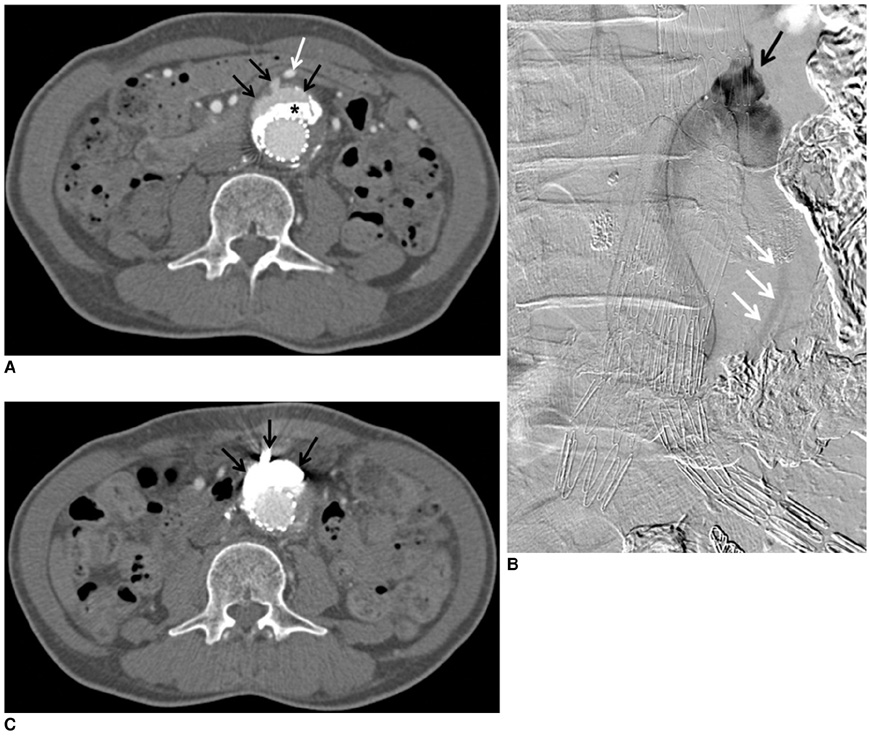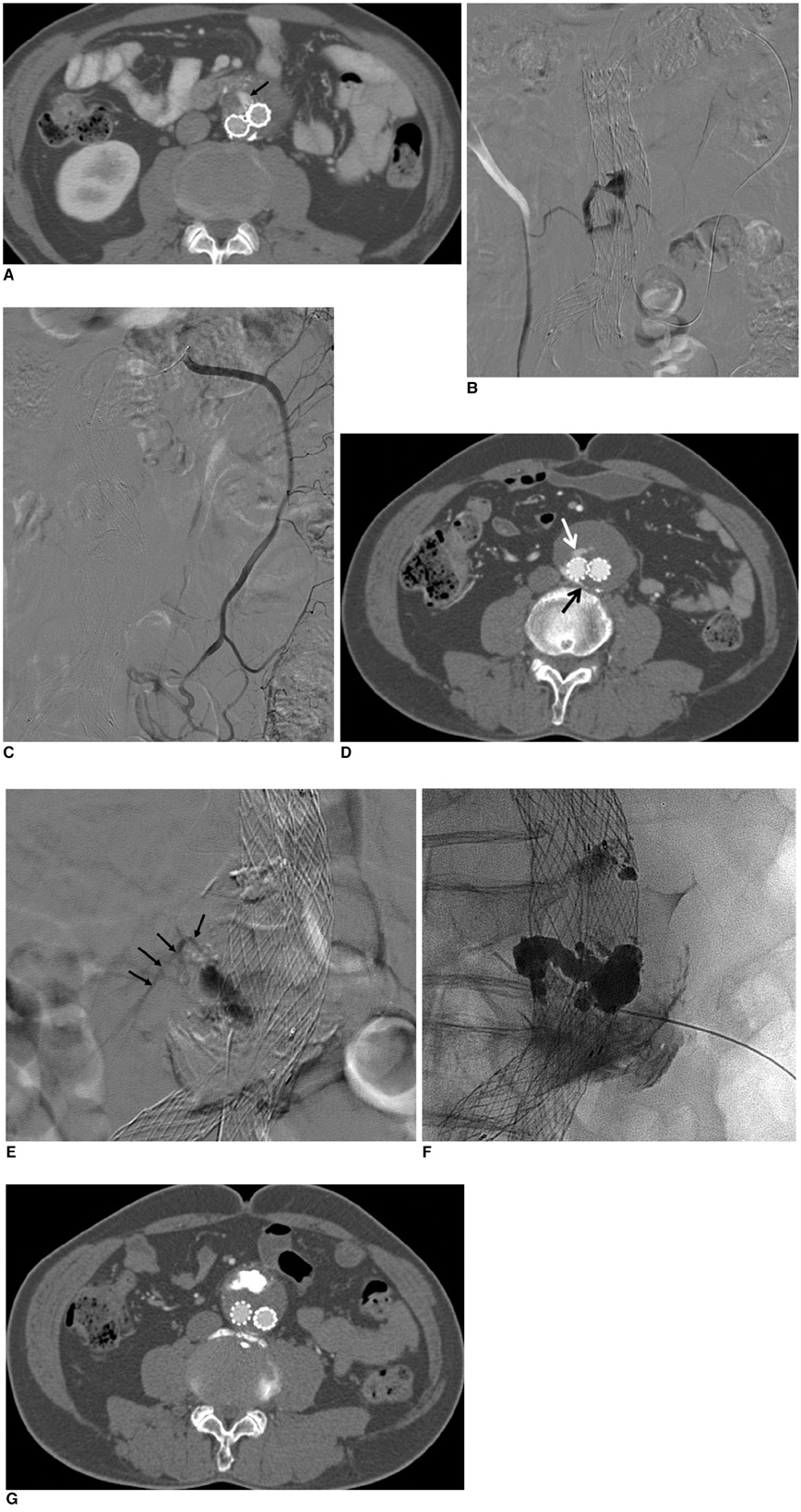Korean J Radiol.
2010 Feb;11(1):107-114. 10.3348/kjr.2010.11.1.107.
Percutaneous Transabdominal Approach for the Treatment of Endoleaks after Endovascular Repair of Infrarenal Abdominal Aortic Aneurysm
- Affiliations
-
- 1Department of Radiology and Research Institute of Radiological Science, Severance Hospital, University of Yonsei, College of Medicine, Seoul 120-752, Korea. doctorlkh@yuhs.ac
- 2Department of Radiology, Gangnam Severance Hospital, University of Yonsei, College of Medicine, Seoul 135-720, Korea.
- 3Division of Cardiology, Yonsei Cardiovascular Center and Cardiovascular Research Institute, University of Yonsei, College of Medicine, Seoul 120-752, Korea.
- KMID: 1787020
- DOI: http://doi.org/10.3348/kjr.2010.11.1.107
Abstract
OBJECTIVE
The purpose of this study was to evaluate the technical feasibility and clinical efficacy of percutaneous transabdominal treatment of endoleaks after endovascular aneurysm repair.
MATERIALS AND METHODS
Between 2000 and 2007, six patients with type I (n = 4) or II (n = 2) endoleaks were treated by the percutaneous transabdominal approach using embolization with N-butyl cyanoacrylate with or without coils. Five patients underwent a single session and one patient had two sessions of embolization. The median time between aneurysm repair and endoleak treatment was 25.5 months (range: 0-84 months). Follow-up CT images were evaluated for changes in the size and shape of the aneurysm sac and presence or resolution of endoleaks. The median follow-up after endoleak treatment was 16.4 months (range: 0-37 months)
RESULTS
Technical success was achieved in all six patients. Clinical success was achieved in four patients with complete resolution of the endoleak confirmed by follow-up CT. Clinical failure was observed in two patients. One eventually underwent surgical conversion, and the other was lost to follow-up. There were no procedure-related complications.
CONCLUSION
The percutaneous transabdominal approach for the treatment of type I or II endoleaks, after endovascular aneurysm repair, is an alternative method when conventional endovascular methods have failed.
Keyword
MeSH Terms
Figure
Reference
-
1. White GH, Yu W, May J, Chaufour X, Stephen MS. Endoleak as a complication of endoluminal grafting of abdominal aortic aneurysms: classification, incidence, diagnosis, and management. J Endovasc Surg. 1997. 4:152–168.2. Buth J, Harris PL, van Marrewijk C, Fransen G. The significance and management of different types of endoleaks. Semin Vasc Surg. 2003. 16:95–102.3. Baum RA, Carpenter JP, Tuite CM, Velazquez OC, Soulen MC, Barker CF, et al. Diagnosis and treatment of inferior mesenteric arterial endoleaks after endovascular repair of abdominal aortic aneurysms. Radiology. 2000. 215:409–413.4. Boks SS, Andhyiswara T, de Smet AA, Vroegindeweij D. Ultrasound-guided percutaneous transabdominal treatment of a type 2 endoleak. Cardiovasc Intervent Radiol. 2005. 28:526–529.5. Kasthuri RS, Stivaros SM, Gavan D. Percutaneous ultrasound-guided thrombin injection for endoleaks: an alternative. Cardiovasc Intervent Radiol. 2005. 28:110–112.6. Ellis PK, Kennedy PT, Collins AJ, Blair PH. The use of direct thrombin injection to treat a type II endoleak following endovascular repair of abdominal aortic aneurysm. Cardiovasc Intervent Radiol. 2003. 26:482–484.7. Greenhalgh RM, Brown LC, Kwong GP, Powell JT, Thompson SG. EVAR trial participants. Comparison of endovascular aneurysm repair with open repair in patients with abdominal aortic aneurysm (EVAR trial 1), 30-day operative mortality results: randomised controlled trial. Lancet. 2004. 364:843–884.8. Prinssen M, Verhoeven EL, Buth J, Cuypers PW, van Sambeek MR, Balm R, et al. A randomized trial comparing conventional and endovascular repair of abdominal aortic aneurysms. N Engl J Med. 2004. 351:1607–1618.9. White GH, Yu W, May J. Endoleak--a proposed new terminology to describe incomplete aneurysm exclusion by an endoluminal graft. J Endovasc Surg. 1996. 3:124–125.10. Sun Z, Mwipatayi BP, Allen YB, Hartley DE, Lawrence-Brown MM. Multislice CT angiography of fenestrated endovascular stent grafting for treating abdominal aortic aneurysms: a pictorial review of the 2D/3D visualizations. Korean J Radiol. 2009. 10:285–293.11. Harris PL, Vallabhaneni SR, Desgranges P, Becquemin JP, van Marrewijk C, Laheij RJ. European Collaborators on Stent/graft techniques for aortic aneurysm repair. Incidence and risk factors of late rupture, conversion, and death after endovascular repair of infrarenal aortic aneurysms: the EUROSTAR experience. J Vasc Surg. 2000. 32:739–749.12. Baum RA, Stavropoulos SW, Fairman RM, Carpenter JP. Endoleaks after endovascular repair of abdominal aortic aneurysms. J Vasc Interv Radiol. 2003. 14:1111–1117.13. Steinmetz E, Rubin BG, Sanchez LA, Choi ET, Geraghty PJ, Baty J, et al. Type II endoleak after endovascular abdominal aortic aneurysm repair: a conservative approach with selective intervention is safe and cost-effective. J Vasc Surg. 2004. 39:306–313.14. van Marrewijk CJ, Fransen G, Laheij RJ, Harris PL, Buth J. EUROSTAR Collaborators. Is a type II endoleak after EVAR a harbinger of risk? Causes and outcome of open conversion and aneurysm rupture during follow-up. Eur J Vasc Endovasc Surg. 2004. 27:128–137.15. Maldonado TS, Rosen RJ, Rockman CB, Adelman MA, Bajakian D, Jacobowitz GR, et al. Initial successful management of type I endoleak after endovascular aortic aneurysm repair with n-butyl cyanoacrylate adhesive. J Vasc Surg. 2003. 38:664–670.16. Golzarian J, Maes EB, Sun S. Endoleak: treatment options. Tech Vasc Interv Radiol. 2005. 8:41–49.17. Faries PL, Cadot H, Agarwal G, Kent KC, Hollier LH, Marin ML. Management of endoleak after endovascular aneurysm repair: cuffs, coils, and conversion. J Vasc Surg. 2003. 37:1155–1161.18. Kasirajan K, Matteson B, Marek JM, Langsfeld M. Technique and results of transfemoral superselective coil embolization of type II lumbar endoleak. J Vasc Surg. 2003. 38:61–66.19. LaBerge JM, Sawhney R, Wall SD, Chuter TA, Canto CJ, Wilson MW, et al. Retrograde catheterization of the inferior mesenteric artery to treat endoleaks: anatomic and technical considerations. J Vasc Interv Radiol. 2000. 11:55–59.20. van Schie G, Sieunarine K, Holt M, Lawrence-Brown M, Hartley D, Goodman MA, et al. Successful embolization of persistent endoleak from a patent inferior mesenteric artery. J Endovasc Surg. 1997. 4:312–315.21. Binkert CA, Alencar H, Singh J, Baum RA. Translumbar type II endoleak repair using angiographic CT. J Vasc Interv Radiol. 2006. 17:1349–1353.22. Baum RA, Cope C, Fairman RM, Carpenter JP. Translumbar embolization of type 2 endoleaks after endovascular repair of abdominal aortic aneurysms. J Vasc Interv Radiol. 2001. 12:111–116.23. Stavropoulos SW, Kim H, Clark TW, Fairman RM, Velazquez O, Carpenter JP. Embolization of type 2 endoleaks after endovascular repair of abdominal aortic aneurysms with use of cyanoacrylate with or without coils. J Vasc Interv Radiol. 2005. 16:857–861.24. van den Berg JC, Nolthenius RP, Casparie JW, Moll FL. CT-guided thrombin injection into aneurysm sac in a patient with endoleak after endovascular abdominal aortic aneurysm repair. AJR Am J Roentgenol. 2000. 175:1649–1651.25. Rial R, Serrano Fj F, Vega M, Rodriguez R, Martin A, Mendez J, et al. Treatment of type II endoleaks after endovascular repair of abdominal aortic aneurysms: translumbar puncture and injection of thrombin into the aneurysm sac. Eur J Vasc Endovasc Surg. 2004. 27:333–335.26. Martin ML, Dolmatch BL, Fry PD, Machan LS. Treatment of type II endoleaks with Onyx. J Vasc Interv Radiol. 2001. 12:629–632.27. Stavropoulos SW, Carpenter JP, Fairman RM, Golden MA, Baum RA. Inferior vena cava traversal for translumbar endoleak embolization after endovascular abdominal aortic aneurysm repair. J Vasc Interv Radiol. 2003. 14:1191–1194.28. Mansueto G, Cenzi D, D'Onofrio M, Petrella E, Gumbs AA, Mucelli RP. Treatment of type II endoleaks after endovascular repair of abdominal aortic aneurysms: transcaval approach. Cardiovasc Intervent Radiol. 2005. 28:641–645.29. Kirby L, Goodwin J. Treatment of a primary type IA endoleak with a liquid embolic system under conditions of aortic occlusion. J Vasc Surg. 2003. 37:456–460.
- Full Text Links
- Actions
-
Cited
- CITED
-
- Close
- Share
- Similar articles
-
- Endovascular Treatment of Abdominal Aortic Aneurysm
- Novel Technique to Rescue a Folded Aortic Endograft during Endovascular Aneurysm Repair
- Changes in suprarenal and infrarenal aortic angles after endovascular aneurysm repair
- Spectral CT Multiparameter Angiography in the Diagnosis of Aortic Stent Endoleak
- Factors Affecting the Endoleaks of Endovascular Aneurysm Repair in Infrarenal Abdominal Aortic Aneurysms




